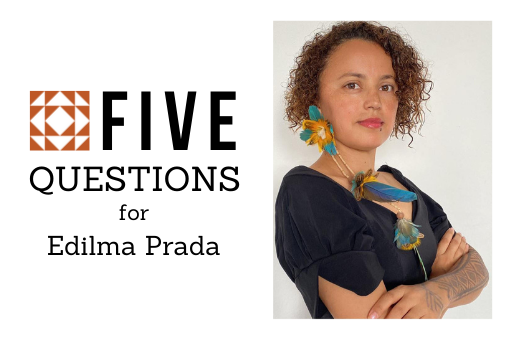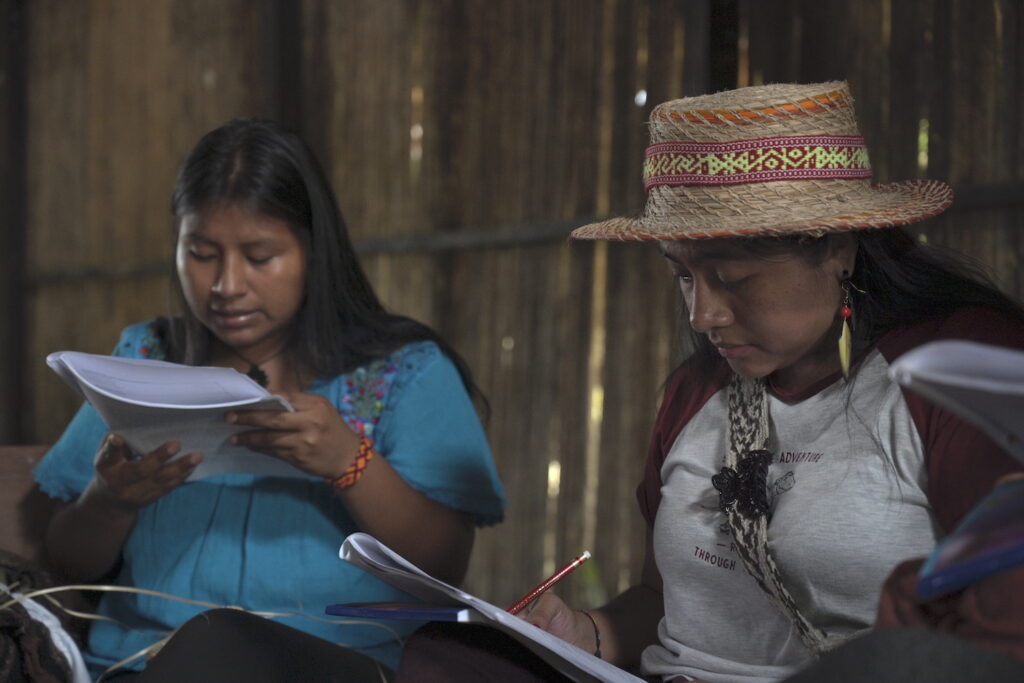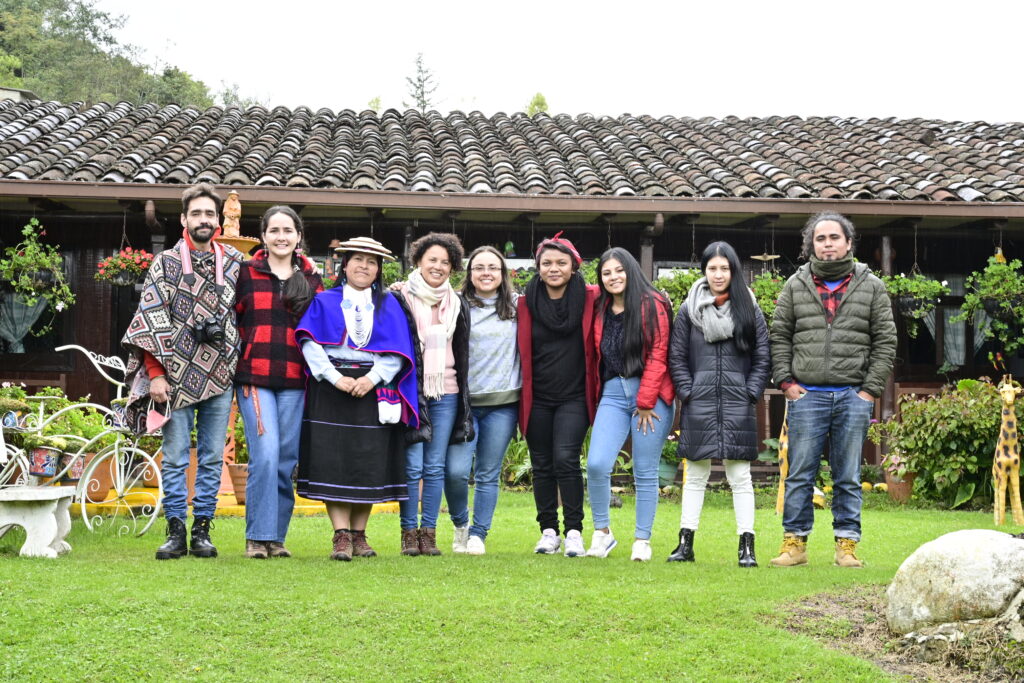The Colombian armed conflict has marked Edilma Prada's journalistic life. Since finishing her studies, in the municipality of Garzón, department of Huila (in southwestern Colombia), she began as a community media reporter in which her daily coverage included topics such as displaced people, terrorist attacks, assassination of leaders, among others. "I started covering these issues somewhat innocently, but it had a lot to do with the community," she said.
Later, as a correspondent for El Tiempo publishing company’s channel, Prada arrived in the department of Cauca (Southwestern Colombia), where these issues not only continued to mark her agenda, but where the conflict was in an even more violent phase, "just before the peace negotiations." It was in Cauca where she saw that, although the armed conflict was one, it was experienced differently depending on the region. In this area, the Indigenous communities were particularly affected. She also learned of the timeless grievance of these communities, especially the Nasa people (mostly located in this area), about the way in which journalists covered their issues.

Informed by this experience and knowledge, Prada founded Agenda Propia in 2011. This news outlet "was born as an editorial response to the lack of responsible coverage or of better valuing the voices of these communities about the realities they were facing, particularly in that territory." Although at the beginning the news outlet focused on the daily life of Cauca, she noticed that the issue of Indigenous communities was important in Latin America (in the region there are more than 800 Indigenous peoples) and that it was better to focus her efforts on producing feature stories that could better showcase that reality.
Working through intercultural teams and councils — which include Indigenous and non-Indigenous journalists — a greater variety of voices is encouraged. They also hold "círculos de la palabra [talking circles]," in which Indigenous community leaders meet with journalists to discuss the reality of the area. The goal is for the story to better reflect the community's way of thinking. The collaborative process, although more time-consuming — it can take up to seven months — is worthwhile, Prada believes.
LatAm Journalism Review (LJR) invited Prada to participate in its "5 questions" section. In this interview, Prada talks about her achievements with Agenda Propia, the press freedom situation in Colombia for Indigenous journalists, and the need for journalists in Colombia not to forget to also cover peacetime stories.
(*This interview has been edited for clarity.)
LJR: About a year ago LJR published a story about the project Red Tejiendo Historias [Weaving Stories Network], created by Agenda Propia, which had the goal of improving coverage of Indigenous communities and issues in the region. Since then, how do you evaluate that process for journalists, and has there been anything particularly satisfying?
Edilma Prada (EP): The Red Tejiendo Historias [Weaving Stories Network] allowed us first to begin to get to know each other, because it is a cross-cultural network of Indigenous and non-Indigenous journalists. So, it has been importante to recognize that in Latin America there is interest from non-Indigenous journalists to cover these issues.
And, on the other hand, there are Indigenous journalists, Indigenous communicators or Indigenous storytellers who are also interested in learning other forms [of storytelling]. Because the network has this cross-cultural orientation in the training, in the creation and collective construction of stories. I feel that there is an interesting opening in the region to make stories with cross-cultural voices, which is one of the most important commitments of the Weaving Stories Network. That is, to be aware that the construction of a story, a feature story done under the methodology proposed by the Agenda Propia network, is done with cross-cultural teams.
To give you an example, for those of us who are not Indigenous journalists, our story is edited or reviewed or advised by Indigenous journalists, Indigenous editors. Or for the journalists who are Indigenous, we make the effort to have a non-Indigenous editor advising.
One year later, as you said, we have produced three co-creations: a series on Voices from the Amazon, a journalistic special on the reality of climate change in Central America and a series on the state of affairs of Mother Earth in Andean countries. First, in these three series we learned that there is a group of cross-cultural storytellers who want to improve their technique, to be able to cover stories of Indigenous peoples.
Second, in the treatment of journalistic stories about Indigenous communities there is a different narrative. We have tried, for example, to include the worldview of each Indigenous community, to include women's voices in the stories, and also to explain the origin and what each Indigenous community represents.
We have managed to tell the story of perhaps over 60 Indigenous communities through these stories that have been written by many journalists, from Mexico to Argentina, in these series I mentioned. In each story we take great care to respect the worldview of each Indigenous community, to explain which community we are talking about and to allow the editing to be collaborative. That is, there are Indigenous and non-Indigenous voices reviewing the text, and even the community described in each feature story decides on the title. Everything is extremely collaborative. Before each production, we hold “talking circles,” to gain clarity about the context, including the voices of Indigenous leaders.
I feel that the process calls for humility, especially for journalists who are non-Indigenous and who were educated in a Western or traditional journalism approach where you have autonomy in everything. That’s not the case here. Here we practice collaboration in the whole process of constructing the stories.
It takes longer, yes, we take longer to produce and to publish. But well, I think that in the end, we also learn something.
LJR: Recently, during World Press Freedom Day, you posted the manifesto #LaPalabraEnRiesgo. You pointed out the violence and the risk to the lives of Indigenous communicators, the lack of attention to what these communities have to say, etc. Could you talk about how you came up with this manifesto and how it has been received, given that it was only recently published?
EP: The reality of Indigenous lands is becoming very complicated. Something that I have been saying in several venues is that what is happening in Indigenous territories is not at all romantic. What is happening in Indigenous territories is violence, crime, assassination of leaders, land theft, and all this is leading to the disappearance and extermination of Indigenous peoples.
And this is also a wake-up call by Indigenous organizations, not only in Colombia, but in the region. COICA, FILAC, a lot of organizations are saying "we have reached a critical moment," and those of us who are in the territory covering Indigenous issues are really coming to this realization.
The reality of Colombia, with crime [against] social leaders (especially Indigenous), drug trafficking which is again strong, reconfiguration of armed groups and discrimination in these elections, that even comes from last year because of the national strike.
We feel that this is an extremely harsh reality, which is affecting first of all the safety of journalists and Indigenous journalists. And journalists who cover these issues are facing some situations of discrimination: [it is] difficult to access public sources or databases, it is difficult for a non-Indigenous authority to acknowledge an Indigenous journalist as a journalist, even a news outlet such as Agenda Propia is being discriminated against because we have a specific editorial agenda, which some label as activist.

Durante la elaboración del Manifiesto #LaPalabraEnRiesgo. (Foto: Vanessa Teteye / Cortesía)
All this has prompted a concern among storytellers and journalists, about the fact that the word is being put at risk and journalists are being silenced as well. And particularly on the issue of Indigenous journalists, because they are also part of an Indigenous community, so it is very difficult to keep a distance from what is happening in Indigenous lands. They are part of the community and their fundamental work is to raise the voice of what is happening in their community. It is very different for a journalist, as in my case, that maybe comes and goes and reports. They are part of the community and this puts them much more at risk as well.
This state of affairs motivated Agenda Propia to lead with this manifesto. So we created an opportunity to meet with Indigenous journalists to talk about what is happening. And this manifesto was also important to give the floor to organizations such as the Truth Commission [of Colombia] and to take into account, first, the history of coverage of the armed conflict. And, second, what we are seeing today as journalists in the territory, regardless of whether they are Indigenous, farmers or Black communities covering the reality of the territories.
So, it came out of a concern about everything that is happening and we managed to gather together. There were over ten of us from different Indigenous communities, many of them from the border areas, speaking from the maloka [communal house] of the Tikuna people, to raise our voices about what is happening. It became a first call we made to defend life and the word.
LJR: The credibility of journalism in the world has been affected — often by valid criticism, sometimes by an intention to invalidate it. What is the current situation of press freedom in Colombia, especially now, on the eve of a presidential election? How much at risk can journalism be?
EP: Yes, I feel that the media is in crisis. I think there are many outlets now to disseminate [information] and citizens do it. I think we citizens have gained those freedoms. But I also think that, well, I prefer to talk about the work we do in Agenda Propia, which is what I know best. I feel that when there is a different editorial line, it is frowned upon, as is the case with Agenda Propia.
We are advocating, for example, a change — in journalism in general — in structure. For example, we tend to think that the official voice is the voice of a mayor or a governor, and if it’s an Indigenous leader, if an Indigenous governor speaks, it has no validity. And this happens a lot in traditional media. If a news story does not include the voice of the current governor, it is not important. If we do not validate as media, as journalists, the voices of the communities of the Indegenous territories and we continue validating the official voices, I think we will continue misinforming and we will continue reporting only one truth. This is regarding the way we do journalism.
The second is that if traditional media or non-Indigenous journalists do not recognize that there are Indigenous journalists doing journalism, it is also another way of discriminating. In Agenda Propia, we have a cross-cultural team. Indigenous people do journalism, they are journalists regardless of whether they are Indigenous or not. This is not taken into account, and when we talk to different actors, the first thing they ask is "do you people do journalism?” If journalism itself does not recognize that Indigenous journalists exist, I believe there will continue to be discrimination. That is why a cross-cultural or multicultural approach is important to us. Both of us do journalism. They have an incredible specificity — Indigenous communities, I mean — because of their different types of knowledge or worldviews.
These realities somehow affect freedom of expression, it affects the non-recognition of other forms of storytelling.
And the last one is to get out of the pigeonhole of journalistic story formats. I believe that there is a diversity in formats that even Indigenous peoples have been doing for millennia that we know nothing about and that we should learn in order to be able to tell stories and to inform.
Not only Indigenous peoples, all communities, whether Black, farmers or other ethnic populations, have their own particularities of storytelling. So, if we follow the same script — title, summary, blah, blah, blah — we are not going to diversify the narratives either.
I close with this: Journalism is one. To label it is also harmful. But it is transparent when it has a clear editorial line. And I think that is beautiful, that our stories are of Indigenous peoples, of communities, and I think it is important that the media also be transparent when they have a defined editorial line.
LJR: Several years ago, you and I talked about a project called Plataforma de Periodismo [Journalism Platform] that aimed to improve coverage of the [Colombian armed] conflict and the post-conflict. You said then that journalists in Colombia "know how to cover war and conflict very well, but not peacetime." This year was the fifth anniversary of the signing of the peace agreement with the FARC. There was an agreement with the self-defense groups. How has the learning process of journalists in terms of post-conflict coverage been, of covering peacetime in the midst of the remaining conflict?
EP: The Plataforma de Periodismo [Journalism Platform] was a wonderful project and, unfortunately, I must say, it is a pity that the organization that led it — which was Consejo de Redacción — had not maintained the project as a community specialized in the subject because the conflict definitely never ceased. It has never, never ceased. It diminished, weapons were silenced for a bit, but a reconfiguration was immediate in many territories in Colombia. The ELN [guerrilla group] and other armed groups were still very active.
But interesting projects and initiatives continue to be carried out by Consejo de Redacción and other organizations, such as the creation of tools, books and guides to make stories of memories, how to make stories of peace, among others, that we should continue doing in Colombia.
And not only in Colombia, but in the whole region [of Latin America]. I still believe it’s still hard for us to think about peace and it is hard for us to think about stories of the Earth: Mother Earth as a large territory, as a common home, among many other realities that even in and of themselves are hard for us to think about.
However, I feel that other narrative possibilities have also opened up that we in the media have implemented through the stories about memories. There have been significant advances in Colombia doing stories and investigations about those memories. Rutas del Conflicto, for example, is a model news outlet in investigating, but also in narrating memory. There are many other initiatives that have emerged in the Colombia.

Equipo intercultural del medio Agenda Propia de Colombia (Foto: Vanessa Teteye / Cortesía)
But I do feel that as journalists we should continue to cover peacetime, remembrances, and reconciliation. We should demand more, in truth, because the new generations do not know that there was a harshness in that conflict and so on. Even in the Indigenous context, we are saying that we need to tell more stories about memories, to tell more stories of truth. I believe the legacies the Truth Commission will leave behind should not be understood only by the Commission, but by everyone. Those stories do not belong to the Commission and the government, those stories that were collected and those testimonies are part of the country, they belong to the country.
And I believe that we must make an effort as journalists to continue covering and uncovering those truths that are still silenced. We must continue to do journalism of memory, of peacetime, of post-conflict — I don't know if we can call it post-conflict — and continue to promote these initiatives of hope in the midst of war.
LJR: You have received grants from different organizations or projects such as the Pulitzer Center, the Amazon Rainforest Journalism Fund and the International Women's Media Foundation. What advice would you give to journalists who would like to obtain these types of grants? And, what has been the most valuable take-away from these experiences?
EP: The most important piece of advice is this: these opportunities are public, open, and these organizations are waiting for more Latinos and Latinas to apply. Four years ago, the Pulitzer Center told me: "very few Colombians apply for this opportunity."
The first thing is to get rid of this notion that this is only aimed for a foreign audience. These organizations are waiting for more journalists to apply, that is the first recommendation.
The second is to have an idea of history. These organizations are also there to help. And I was pleasantly surprised because all the stories that have been proposed, in my case, have been about Indigenous peoples and these stories have a place or are well-received.
In addition, there are some realities, such as the case of Amazonia, that are generating a lot of funds and a lot of interest in telling what is happening. So, I think we also have to look at territories where there are opportunities to apply with story proposals. I think we have to trust that, from the regions, from countries like Colombia, even with all these difficulties, good journalism is being done. If we believe that in Colombia there is good journalism, that is responsible, that investigates, that contrasts, that raises the voices of silenced communities, there are spaces and opportunities to publish these stories.